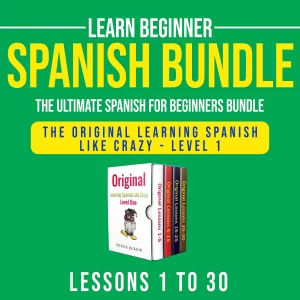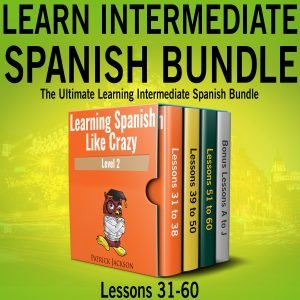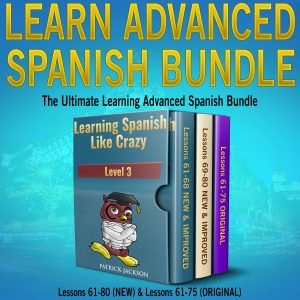Regular –ar, -er and –ir verbs
In We established that the subject of the sentence is often omitted in Spanish, especially when the subject is a pronoun. The reason is that conjugated[1] Spanish verbs indicate whether the subject is first, second, or third person,[2] and also whether the subject is singular or plural. Observe the sentences below:
¿Tienes hijos? Do you have children?
Tengo tres hijas. I have three daughters.
Both sentences use conjugated forms of the Spanish verb tener (to have). Notice that have is rendered differently in the two Spanish sentences and that the sentences omit the pronouns tú and yo. The conjugated form tienes is only used with tú, and tengo is only used with yo. The inclusion of pronouns in this example (Yo tengo tres hijas. ¿Tú tienes hijos?) would emphasize the subject (I have three daughters. Do you have children?) and could be taken as condescending, obnoxious or confrontational!
This lesson will lay the groundwork for your study of Spanish verbs. There are 14 tenses, as well as imperative (command) and passive voice conjugations. At this point in your studies, you should consider investing in a book of verb conjugations, which provide all of the forms of selected verbs. Some books have a few hundred verbs, some have a few thousand; since Spanish verbs usually follow predictable patterns, you’re not necessarily missing out if you start with a basic 100-verb guide. Students, professors and translators use these books for reference. As a beginner, I recommend you read as much as possible in Spanish, whether it’s the newspaper, a magazine, or a cereal box, and use the verb conjugation book along with your bilingual dictionary (if you don’t have one, get one!) to build your vocabulary and “discover” the grammar for yourself.
-ar verbs
First things first: all verb infinitives[3] in Spanish end in –ar, -er or –ir. The ending of the infinitive determines the way the verb will be conjugated. Verbs that follow the conjugation rules are simply called regular verbs. There are many irregular verbs and groups of verbs with consistent, alternate sets of rules, which we’ll study later. For this lesson, we’ll begin with a list of regular –ar verbs:
| bailar | to dance | invitar | to invite |
| cambiar | to change | llamar | to call |
| cantar | to sing | mandar | to send; to order |
| cocinar | to cook | mirar | to look |
| comprar | to buy | pagar | to pay |
| enseñar | to teach; to show; to point out | preguntar | to ask |
| estudiar | to study | preparar | to prepare |
| hablar | to speak | trabajar | to work |
Think about the present tense conjugation of the English verb to speak: I speak, you speak, we speak, they speak, he speaks, she speaks, it speaks. There are only two conjugated forms: speak and speaks. Notice that the conjugated form speak is the same as the base form. In Spanish, there are six individual present tense conjugated forms for all regular verbs, and each conjugation is different from the base. I use the “verb tree” below to introduce conjugation patterns. Singular and plural forms are opposite one another, and conjugations on the same line are the same person. Here is the verb tree for the present tense of hablar:
-
hablar
yo hablo nosotros hablamos tú hablas vosotros habláis él hablaella habla Ud. habla
ellos hablanellas hablan Uds. hablan
Study the verb tree. Can you describe how the conjugated forms relate to the infinitive? The –ar ending in the infinitive is in bold because the ending will be dropped in present tense conjugated forms. Habl- is the base of the verb; conjugation will involve adding the correct ending to this base. Notice that each conjugated verb contains the base habl- plus an ending. El, ella, usted and their plural forms are all in the third person in Spanish, and there is only one singular and one plural conjugation per person.
Kind of fun, isn’t it? Use the pattern to conjugate preparar, and check your answers at the end of the lesson before you move on to –er and –ir verbs.
-
preparar
yo _____________ nosotros ___________ tú _____________ vosotros ___________ él ella ____________ Ud.
ellos ellas ______________ Uds.
-er and –ir verbs
Good news: if you can conjugate a regular –ar verb, you’ll have no trouble with regular –er and –ir verbs. And more good news: regular –er and –ir verbs share four of the six conjugated endings. Here are –er and –ir verb trees, side by side:
| aprender | escribir | ||
| yo aprendo | nosotros aprendemos | yo escribo | nosotros escribimos |
| tú aprendes | vosotros aprendéis | tú escribes | vosotros escribís |
| él ella aprende
Ud. |
ellos ellas aprenden
Uds. |
él ella escribe
Ud. |
ellos ellas escriben
Uds. |
Where are the differences? The nosotros and vosotros endings are different in –er and –ir present tense conjugations. Did you notice that the yo ending is always –o in regular present tense verbs? What other patterns do you see among the three types of verb endings? Notice that the tú form always ends in –s. Notice that the ellos, ellas, Uds. form always ends in –n. These consistent patterns will help you make sense of what you read and hear, especially when the subject of the sentence is omitted.
We’ll end this lesson with vocabulary lists of regular –er and –ir verbs. All of the verbs in this lesson are regular verbs, so you will be able to conjugate them using the verb trees. Make sure you use –er endings for –er verbs, etc. It’s vital that you begin building your vocabulary right away! Your grammar skills won’t matter if you don’t know what the words mean!
| aprender | to learn | correr | to run |
| beber | to drink | leer | to read |
| comer | to eat | prometer | to promise |
| comprender | to understand | ver | to see |
| abrir | to open | recibir | to receive |
| asistir | to attend; to assist | subir | to climb, to raise |
| discutir | to discuss | sufrir | to suffer |
| escribir | to write | vivir | to live |
Practice
Translate these phrases. Be sure to conjugate the verbs correctly. For this exercise, please include all pronouns in Spanish as well as English.
| ______________ | we live | ______________ | they work |
| él abre | ______________ | ______________ | she learns |
| ellos sufren | ______________ | escribimos | ______________ |
| ______________ | I cook | Ud. ve | ______________ |
| tú compras | ______________ | yo enseño | ______________ |
| ______________ | you prepare | ______________ | he asks |
| ellos cantan | ______________ | ______________ | they pay |
| ______________ | he reads | ______________ | I promise |
| Uds. hablan | ______________ | tú comprendes | ______________ |
| aprendéis | ______________ | ______________ | we discuss |
Answers
Conjugation of preparar:
yo preparo nosotros preparamos
tú preparas vosotros preparáis
él, ella, Ud. prepara ellos, ellas, Uds. preparan
| nosotros vivimos | we live | ellos trabajan | they work |
| él abre | he opens | ella aprende | she learns |
| ellos sufren | they suffer | escribimos | we write |
| yo cocino | I cook | Ud. ve | you see |
| tú compras | you buy | yo enseño | I teach |
| tú preparas* | you prepare | él pregunta | he asks |
| ellas cantan | they sing | ellos pagan | they pay |
| él lee | he reads | yo prometo | I promise |
| Uds. hablan | you speak | tú comprendes | you understand |
| aprendéis | you learn | nosotros discutimos | we discuss |
Denise Pettek is the author to this Spanish lesson.
*Also acceptable: Ud. prepara, vosotros preparáis and Uds. preparan.
[1] To conjugate is simply to use the form of the verb that agrees with the subject and tense. “He be my husband” is incorrect because the verb is not conjugated. “He are my husband” is incorrect because are is the wrong conjugated form for this subject. (Some sources use the term inflected form.)
[2] First person: I, we Second person: you Third person: he, she, it, they
[3] An infinitive is the unconjugated form of the verb. In English, to be is the infinitive, and be is the base form. The conjugated forms of to be include am, are, is, was, were, will be, etc.





